The MB Official Pac-Man Board Game
“Race your hungry Pac-Man and chase the Ghosts. Watch him open and close his mouth as he gobbles every marble along the track.”
You as an NTS reader and/or Pac-Man fan and/or board game player probably know about the awesome hand-made Pac-Man board game that my sister and her husband gave me as a birthday present. If not, read up!
MB also released a Pac-Man board game - the official one, so to speak - as far back as 1982, only two years after Pac-Man’s first appearance. I’ve had it sitting on my shelf for a while, waiting to be played and reviewed. And when John and Tanya came to visit me in Germany last weekend, we thought we’d playtest it a bit. Here’s the report for you!
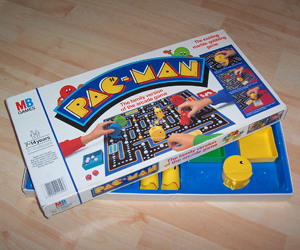
Game contents
- Game board
- Four plastic Pac-Man figures
- Four trays for players to collect their loot in
- Two plastic ghosts
- Spherical white pac-dots, confusingly referred to as “marbles”
- Four yellow power-pellets (also “marbles”)
- Two six-sided dice (in theory anyway, the one I got on e-bay didn’t have any!)
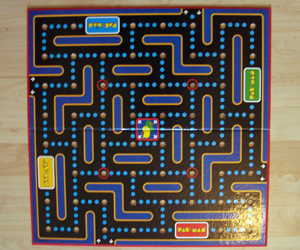
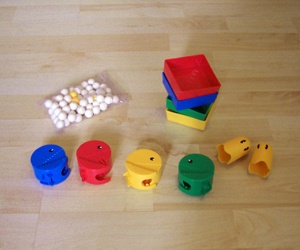
Basic game information
- 2-4 players of age 7-14
- No duration on the box; we say it’s approx. 30 minutes
Setting up the game
Preparing the game is pretty straightforward. For the sake of completion: board goes on table, white and yellow marbles go on board, Pac-Man figures go on their assigned starting positions (according to their colour) and the ghosts go in the shed. The board is made from sturdy cardboard, and it’s got holes cut into it to prevent the marbles from rolling off into the wild - a good idea in theory. In actuality, we did lose our marbles our marbles did escape us several times (oh ha ha). But maybe we’re just a bit crap at this.
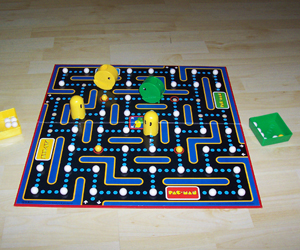
How to play
Players take turns to:
- Throw the dice
- Use one die to move their Pac-Man
- Use the other die to move one of the ghosts
Note that dice values have to be used up completely if possible. Note that Pac-Man cannot pass or land upon another Pac-Man, and ghosts cannot pass or land on top of each other. If a path is blocked, your Pac-Man has to be moved in a different direction. No-one is allowed to turn around 180° and go back the way they came during one move. Pac-Man and ghosts ignore other players’ starting fields.
The following can happen:
- Pac-Man passes (or lands on) a field with a white marble: Pac-Man munches the marble.
- Pac-Man passes (or lands on) a field with a yellow marble: Pac-Man munches the marble.
- Pac-Man moves onto a "tunnel" field: Pac-Man is allowed to move off the board and re-enter it at any one of the three other tunnels.
- Pac-Man moves into a ghost:
- If the player has a yellow "ghost gobbler privilege" marble: Pac-Man’s move ends here (and remaining steps are not used). Pac-Man’s player gets to steal two marbles of a player of his/her choice. The ghost is sent to the ghost shack. The yellow marble is returned to any vacant yellow marble spot on the board (the player’s choice).
- If the player does not have a yellow marble: Pac-Man is sent to his starting position.
- A ghost moves into Pac-Man: Pac-Man is sent to his starting position. The ghost’s remaining steps are not used up. The ghost’s player gets two of Pac-Man’s white marbles.
- A ghost moves onto a “tunnel” field: The ghost is not allowed to move off the board.
- All marbles have been eaten: The game ends. The player with the most white marbles collected wins. Yellow marbles are not counted.
Problems with the rules
There are one or two situations that the rules managed not to cover, so we made up our own. We ran into these immediately after starting to play, so I did ask myself whether the game was playtested by anyone at all before its release.
For instance, the rules explicitly state that players are allowed to move a ghost onto their own Pac-Man, sending it back to their starting space. But is Pac-Man allowed to suicide into a ghost – i.e. move into a ghost without holding a yellow marble? If so, what happens? We decided that it was allowed, on the grounds that in the actual Pac-Man game it is perfectly possible, and that the Pac-Man is sent back to its starting space but not losing any marbles.
The rules do eludicate and illustrate in detail how to “Peel the eye labels from the sheet. Attach 2 round labels to each Pac-Man and 2 oval labels to each Ghost (fig. 4).” Only about half of the space is dedicated to the actual gameplay - a questionable decision.
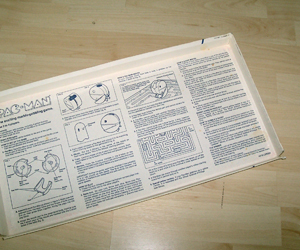
Our Impressions
Let me start with the gaming material. The maze on the board is point symmetric, so it is the same for any of the two to four players. This also means that the maze is not the one from the actual Pac-Man game. I can see why it was done this way, but it’s still somewhat of a shame. The plastic ghosts and Pac-Man figures shout “eighties!” in your face, but that’s not necessarily a bad thing. In fact, in all their corny plastic glory and overall cartoonish style, they’re actually kind of cute. The marbles tend to roll off as already mentioned, and the yellow marbles should be red. (Okay, now I’m just being anal.)
And now for the gameplay...
Judging the game by its rules, we had had certain expectations. Moving was more complicated than expected. The rules text could have been clearer (again: or maybe we’re just rubbish). We had to consult the rules several times even after the initial "open" round of what-are-we-actually-supposed-to-be-doing-here. MB should have provided a flowchart.
The game is based heavily on luck with the dice. However, it turned out in fact to have a tactical component. Towards the end the matches picked up on speed and tension - players teamed up against the player currently in the lead, blocked paths so the leading player couldn’t munch the last marble and end the game, and so on. It was actually more fun than any of us had expected beforehand.
Another highlight was munching the marbles with the plastic Pac-Man figures. (Simple people, simple tastes!) It was fun to do, in a haptical sense. Although John didn’t always quite manage to operate his Pac-Man. Also, the plastic Pac-Man figures have jaws attached that you can move a bit. Of course those jaws are not actually good for anything, which makes them especially fun in a way.
However, it did get old after two or three rounds of approximately 30 minutes each. Granted, none of us meet the age recommendation (far from it, I’m afraid). It is a game for kids. Once you know the what-happens-ifs, it’s really fairly easy and relatively fast. Luck remains the biggest factor in the game in terms of winning/losing which after a while I found a bit annoying.
Suggestions for rule enhancements
On a playing board of 8 x 8 squares, rolling a six will take you quite far. Rolling two sixes in a row dramatically increases the probability of an early win. In order to make the game a little more tactical, players could use lower dice instead of the six-sided ones - a D3 or D4.
One thing that annoyed us on a principle level was that you could be eaten by a ghost while being in possession of a yellow marble (ghost gobbler privilege). The marble should grant Pac-Man immunity and send the ghost back into the ghost shed, and then be lost - no matter whether a ghost moves into Pac-Man or Pac-Man moves into a ghost. So moving a ghost into Pac-Man currently holding the ghost gobbler privilege would become a device not for taking marbles off a player, but for making a player lose one of his yellow marbles, which then would be returned to the board by the ghost’s player.
So, yes, it was fun, although I obviously prefer my sister’s. I’m of course biased though, so I asked John whether he would provide a second opinion on and possibly comparison of the two games...
Second Opinion
By John Hoare
Adaptations from one media to another always bring up the same questions. How do you stay true to the original vision, and retain enough of what made something good in the first place, and yet create something that isn't just a tired retread of the original, and takes full advantage of the new medium? It's talked about with books turned into films, and films turned into videogames... and yet the same is just as true of videogames turned into board games.
And so it is with this MB game that I can get annoyed about the placement of the power pills (they should be in the corners, dammit), the fact that THE MAZE IS WRONG, the fact that the ghosts are the same colour - all decisions that make actually sense within the adaptation, and yet annoys my inner, and outer, geek. To be fair, it's also more fun than I expected, but after three or so playthroughs, it really has run out of things to offer; the balance between tactics and luck are skewed far too much towards the latter. And maybe it is unfair to criticise a game designed for 7-14 year olds, but as the original videogame can be played by any age, I'd argue it's still symptomatic of a weakness in the game. (And there's plenty of things I enjoy today that was originally aimed at that age range anyway.)
But this idea of how you adapt something into a different medium is actually what makes Marleen's sister's game so special. It tickles the inner nerd with its faithful reproduction of the board, non-player-controlled ghosts, properly-coloured Pac-Men, and so on... and yet has the intelligence to realise that the game doesn't really translate effectively as a board game unless you add a new element - the question cards. A Pac-Man Trivial Pursuit, if you will. So you get all the geeky elements... and yet it actually works as a proper board game in its own right. Board games - in casual settings, at least - thrive on not just the basic rules, but the interaction between the players. With the MB game, you can have a bit of fun blocking people, but it's nowhere near as much fun as laughing at someone for being shit at not being able to name a single Knight of the Round Table. When you know damn well that that person loves Monty Python and the Holy Grail.
Adaptation is all about what you leave in, what you take out, and what you add. The MB game doesn't completely muff it, but neither does the game soar. The hand-made game, on the other hand, genuinely transcends its roots to become something that is completely new, and yet still worthy of being called Pac-Man.
Not quite how it's supposed to work, is it?
About this entry
- By Marleen
- Posted on Friday, June 26 2009 @ 12:22 am
- Categorised in Games, Review
- Tagged with pac-man
- 4 comments

How does the chomping action of the pac-man pieces work?
By Dave Chester
July 23, 2009 @ 9:26 pm
reply / #
There’s a sort of jaw-piece on the bottom which helps the marbles into the piece through a hole. It’s difficult to describe, but you align the marble with the hole and then push down. It’s quite satisfying!
By Tanya Jones
July 23, 2009 @ 9:55 pm
reply / #
Basically, it works like this:
By Marleen
July 27, 2009 @ 8:35 am
reply / #
Ha! Exactly!
By Tanya Jones
July 28, 2009 @ 7:47 am
reply / #